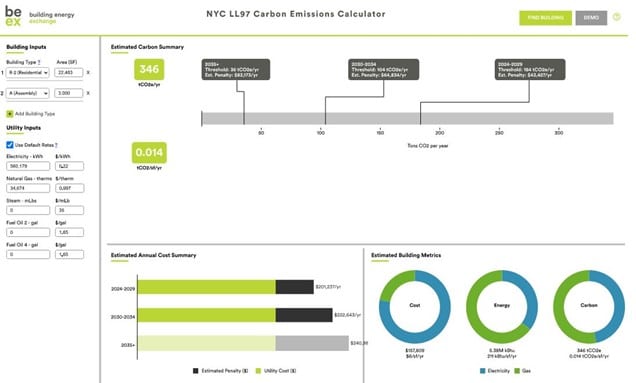What is Local Law 97, and how will it affect where I live in New York City?
To better understand Local Law 97 (LL97), we need to understand how and why it came about.
This law arises from a generally unknown and rather astounding fact. New York City residents are accustomed to spending their lives in one of the world’s most densely built urban environments. We live inside and are surrounded by countless buildings of all heights and sizes; yet, it would likely come as a surprise to most of us that these very buildings—where we live, work, learn, and enjoy ourselves—account for a whopping 71% of the city’s greenhouse gas (GHG) emissions, surpassing even transportation emissions!
In 2019, the New York City Council passed the NYC Climate Mobilization Act (CMA), which aims to effectively and significantly address this issue. Also known as NYC’s Green New Deal, it comprises several laws that aim to reduce New York City’s building carbon or greenhouse gas (GHG) emissions by 40% by 2030 and by 80% by 2050. This law affects 50,000 of New York City’s one million buildings.
How does CMA reduce buildings’ carbon emissions?
CMA requires that owners of residential and commercial buildings over 25,000 square feet in size invest in renovation and retrofitting to make their buildings more energy efficient and eventually meet the established emissions caps. What is the estimated cost for New York City’s building owners? The cost is estimated at $4 billion USD, but it’s believed that some of those costs will likely also create future energy savings for these buildings.
What building retrofits make a building more energy efficient and compliant with LL97?
Building owners and managers can consider investing in a number of energy conservation measures, such as implementing mechanical system upgrades, installing dimmable lighting systems, replacing uninsulated windows and failed building envelope perimeter seals, in addition to other building improvements.
How do I find out if my building is required to do such retrofits to comply with LL97?
The first threshold to be considered is the size of the building; all buildings taller than 25,000 square feet are required to comply with LL97.
If your building meets that first threshold, LL97 sets two initial phases of emissions caps, or limits, for eligible buildings.
The first phase began in 2024 and continues until 2029, while the second, more stringent, phase will take place in 2030-2034. The caps or limits were set based on several different building use classifications and sizes.
How do I know where my building presently stands vis-à-vis the new emission requirements?
A good place to check is the Building Energy Exchange calculator. Your building’s yearly emissions reports should already be there, as required by the previously enacted Local Law 84, which requires that all eligible buildings submit these annual energy audits. If your building has not submitted these reports, an engineering firm should be engaged to perform an LL97 energy audit.
How is this Calculated and Determined?
The emissions intensity limits set by Local Law 97 were determined for 10 classifications of buildings based on Building Code occupancy groups. A building’s annual emissions limit is its emissions intensity limit multiplied by floor area. Below is an example of a building Carbon Emissions Calculator result for a pre-war building (Bldg. A as an example) that is just above 25,000 square feet in size:

What are the penalties for non-compliance?
The penalty for not complying with LL97 is a fine, calculated by taking the difference between a building’s annual allowable emissions limit and its actual emissions, then multiplying the difference by $268/sf. The law establishes a fine of $268.00 for each metric ton of CO2 a building emits that is over the allowable amount established for each year. For example, the building referenced above (Bldg. A) is composed of 22,483 square feet of residential apartments on the 2nd through 7th floors (Occupancy Group R-2), and the ground floor features a 3,000-square-foot restaurant (Occupancy Group A). Based on the building occupancy, the allowable GHG emissions for this property are calculated as follows:
|
Occupancy Group |
Emissions Limit |
Gross Floor Area |
Total GHGs |
|---|---|---|---|
|
A |
0.01074 (tCO2e/sf) |
3,000 sf |
32.22 |
|
R-2 |
0.00675 (tCO2e/sf) |
22,483 sf |
151.76 |
|
Total Allowable GHG Emissions |
183.98 |
The building has filed its annual energy benchmarking reports following Local Law 84, and the latest GHG emissions report indicates a total of 346 tCO2e/yr, which is 162 tCO2e/yr over the 2024 – 2029 allowable limits. The LL97 penalty assessment for this property would be as follows:
- Current GHG Emissions = 346 tCO2e/yr (162 tCO2e/yr over allowable)
- Fine Assessment: 162 tCO2e/yr x $268.00 = $43,416.00/year
The allowable GHG emissions are decreased to 104 tCO2e/yr for the second phase of LL97 in 2030 – 2034. The penalty for this property would increase to $65,000/year if no energy conservation measures are implemented to reduce the current amount of annual GHG emissions.
How Rimkus can help
Rimkus offers a program to perform a comprehensive analysis of both the building mechanical systems and envelope assemblies. This analysis is needed to provide building owners with the most holistic view of where energy is being lost and what steps may be taken in carefully planned, incremental phases to bring their property to compliance with the forthcoming LL97 regulations.
Rimkus is an engineering leader in the field of building envelope assessment, inspection, and restoration both in New York and across the United States. We bring years of experience to help you and your building effectively and efficiently meet LL97 compliance.
About the Author
By John Rudisill, Senior Practice Leader, Rimkusopens in a new tab
For information about our Façade Ordinance Inspection Services:
Disclaimer
This article aims to offer insights into the prevailing industry practices. Nonetheless, it should not be construed as legal or professional advice in any form.